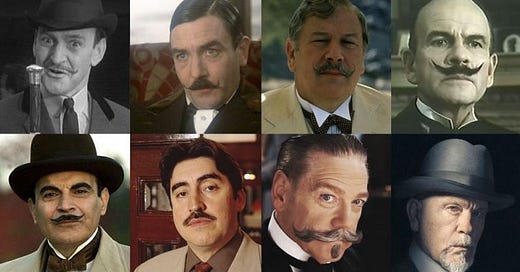In 2024, I read all 63 of Agatha Christie’s novels, starting with the Miss Marple books (which I wrote about here). After finishing reading about that old pussy, I moved on to the Poirot novels.
Since there are so many of them, I’m breaking this into two posts. This one will discuss, chronologically, the first part of this series, most of which I really enjoyed1!
The Mysterious Affair at Styles (1920)
In which we meet Belgian refugee Hercule Poirot, newly arrived in England after World War 1. This book is the OG for what I think of as an Agatha Christie murder mystery: an isolated manor full of guests with secrets.
Poirot level: high
The Murder on the Links (1923)
Poirot and his BFF Hastings go for a holiday in northern France, and a murder occurs wherein the dead body is found in a freshly dug grave near a golf course. Hastings falls in love in this one, then moves to Argentina.
Poirot level: high
The Murder of Roger Ackroyd (1926)
This is a famous one. With Hastings gone, the narrator/assistant task is done by Dr. James Sheppard. One of Christie’s moves famous twist endings. Basically, Poirot (and Sheppard) investigate the maybe-murder of a man and the maybe-suicide of his wife.
Poirot level: high
Hastings is back, and he joins Poirot for a holiday in Cornwall, where a young woman says someone is trying to kill her, and Poirot does his best to protect her. Naturally, a murder occurs.
Poirot level: high
Poirot (and Hastings) investigate the death of the titular Lord Edgware, who, along with his wife, dies following a thirteen-guest dinner party.
Poirot level: high
Murder on the Orient Express (1934)
A famous one! Maybe my favourite. Poirot’s bad luck while on holiday continues as he books a last-minute seat on the Orient Express just in time for a murder to occur. One of the most famous twist endings.
Poirot level: high
Poirot attends another ill-fated dinner party, this time with his friend Mr. Satterthwaite. One guest dies at the dinner, then later on two more guests die at a dinner party with the same guests. Poirot is on the case!
Poirot level: high
I really enjoyed this one. Rather than a train, this one is about Poirot on a small airplane where someone dies from (seemingly) an insect sting. OR WAS IT??
Poirot level: high
Poirot (and Hastings) investigate a serial killer who goes after people with alliterate names (beginning with a victim named Alice Ascher).
Poirot level: high
While writing all her books, Agatha Christie divorced her shitty first husband, had a mental breakdown, went on a trip, fell in love with and married an archaeologist, then began regularly accompanying him on trips. This is why Poirot suddenly takes so many trips to archaeological sites in the East. This one finds Poirot at an archaeological excavation in Iraq where someone is murdered. A good twist ending.
Poirot level: high
This is Hastings’s last appearance for a while. Poirot investigates a woman who thinks someone tried to kill her; the only witness is her dog.
Poirot level: high
Poirot goes on holiday in Egypt, where, yet again, he is approached by a woman who thinks someone is trying to kill her. Murder ensues! This one has another good twist ending.
Poirot level: high
Poirot continues his archaeology-based travels, landing this time in Jerusalem and Petra. A murder occurs, and he has only twenty-four hours to solve it. Another good one!
Poirot level: high
Hercule Poirot’s Christmas (1938)
This is where one can sense Agatha Christie is getting tired of writing about Poirot, as he only appears midway through the book. It’s a very proto-Knives Out scenario, where the elderly patriarch of a family calls his family together so he can update his will, and then he (spoiler?) dies. Poirot investigates (once he shows up).
Poirot level: medium-high
The other Poirot books from this time period, which I did not enjoy as much are The Mystery of the Blue Train (1928) and Cards on the Table (1936).
Are these books a product of their time, and of the mind of an upper-class white British woman born in 1890, and therefore include racial slurs and stereotypes sometimes when one least respects them? Yes. Please just note that in this post I’m strictly talking about the plotlines, not the cultural portrayals of non-white people (which vary from “ok” to “oh no yikes” depending on the book).




